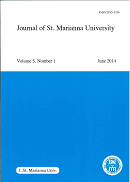Volume 13, Issue 2
Displaying 1-11 of 11 articles from this issue
- |<
- <
- 1
- >
- >|
Original Article
-
2022Volume 13Issue 2 Pages 51-57
Published: 2022
Released on J-STAGE: March 09, 2023
Download PDF (2219K) -
2022Volume 13Issue 2 Pages 59-68
Published: 2022
Released on J-STAGE: March 09, 2023
Download PDF (737K) -
2022Volume 13Issue 2 Pages 69-75
Published: 2022
Released on J-STAGE: March 09, 2023
Download PDF (1338K) -
2022Volume 13Issue 2 Pages 77-86
Published: 2022
Released on J-STAGE: March 09, 2023
Download PDF (1363K) -
2022Volume 13Issue 2 Pages 87-93
Published: 2022
Released on J-STAGE: March 09, 2023
Download PDF (548K) -
2022Volume 13Issue 2 Pages 95-100
Published: 2022
Released on J-STAGE: March 09, 2023
Download PDF (1494K) -
2022Volume 13Issue 2 Pages 101-111
Published: 2022
Released on J-STAGE: March 09, 2023
Download PDF (1194K) -
2022Volume 13Issue 2 Pages 113-125
Published: 2022
Released on J-STAGE: March 09, 2023
Download PDF (1558K) -
2022Volume 13Issue 2 Pages 127-135
Published: 2022
Released on J-STAGE: March 09, 2023
Download PDF (1131K) -
2022Volume 13Issue 2 Pages 137-147
Published: 2022
Released on J-STAGE: March 09, 2023
Download PDF (1168K)
Case Report
-
2022Volume 13Issue 2 Pages 149-154
Published: 2022
Released on J-STAGE: March 09, 2023
Download PDF (1303K)
- |<
- <
- 1
- >
- >|
